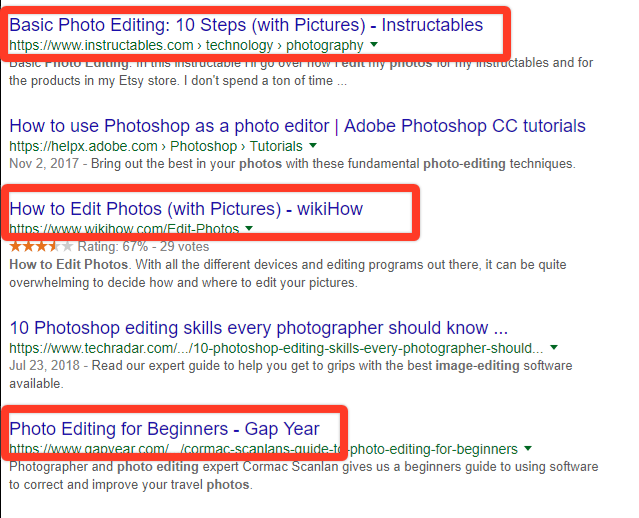If you want to drive more relevant traffic to your site and increase conversions, here's how to create a user-intent SEO strategy. In order to create a user-intent SEO strategy for your content, you first need to understand the different types of user intent. In the example below, I used Google search results to demonstrate the three stages of user intent. For example, the user might search for “how to edit photos.” Notice how all the results for that Google search are informational, like how-to blog posts and tutorials. There are no ads on the page because users are only searching for information and not a particular product they want to buy. The sites aren't presenting informative blog posts, but product pages. Now that you understand the different stages of user intent, you can see what types of content you need to provide for users and what types of key phrases you should be optimizing your content for in order to enhance the relevance of your posts and improve your rankings. Create content for user intent. Instead, you’ll show up in search results related to gardening. That way, when users in the informational stage discover you, then move on to the next stage, they’ll find helpful content from you again -- and you can lead them all the way to buying your product.

Opinions expressed by Entrepreneur contributors are their own.
Behind every Google search, there is an intention. People are looking for something in particular when they’re searching the web — the answers to their problems, information about the services available to them or sources for the product they want. If you want your business to be discovered by users on the web, your content needs to be optimized for user intent.
Since Google can recognize user intent, it displays pages in search results that are most relevant to what the user is looking for. Because of this, understanding user intent and creating content with the user’s intent in mind is essential to improving the relevance of your website pages and improving SEO.
If you want to drive more relevant traffic to your site and increase conversions, here’s how to create a user-intent SEO strategy.
Understand the different types of user intent.
In order to create a user-intent SEO strategy for your content, you first need to understand the different types of user intent. Start by heading over to Google. Enter the search terms your audience would be looking for; and, based on what turns up, you’ll easily be able to identify what type of content users want at each different stage of user intent. In the example below, I used Google search results to demonstrate the three stages of user intent.
1. Informational search queries
In the informational search queries stage, the user is trying to gather more information about a particular topic or product, but he or she is not ready to buy. For example, the user might search for “how to edit photos.”

Notice how all the results for that Google search are informational, like how-to blog posts and tutorials. There are no ads on the page because users are only searching for information and not a particular product they want to buy.
2. Navigational search queries
In the navigational search queries stage, the user is looking for a specific type of content to help him or her consider their options, but is still not quite ready to buy. The user will search, for example, for “What is the best photo editing software?”

In this stage of user intent,…

COMMENTS